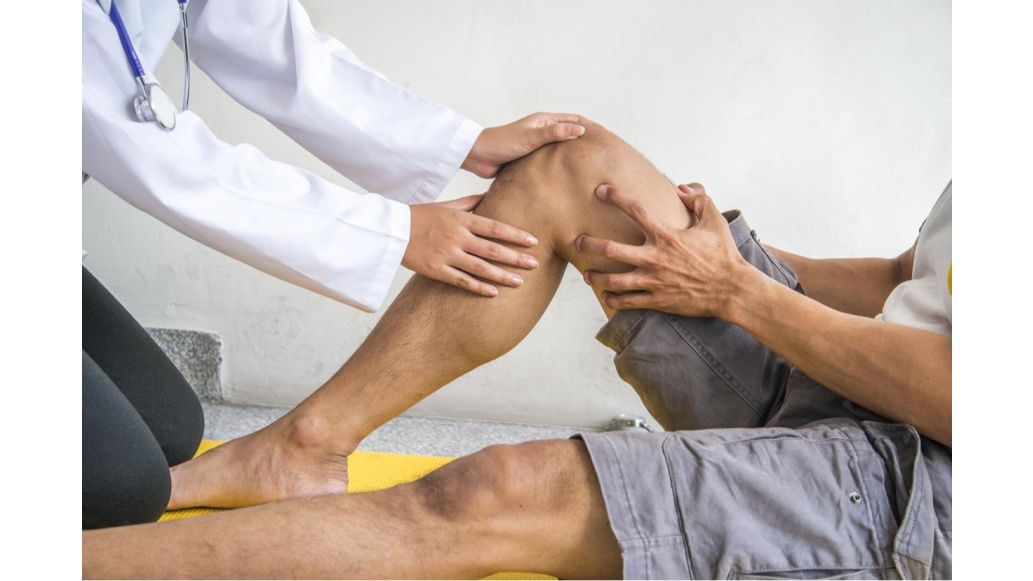You may think you have everything you need to buy before a knee replacement, like a grab bar or a sock aid, or maybe you even purchased a knee kit. But you’re not done preparing yet! While those products will help you care for yourself after your knee replacement, these pre-surgery exercises will help your knee recover after surgery.
- What is a knee replacement and who needs one?
- Knee Replacements and COVID-19
- Why should you exercise before knee replacement surgery?
- 13 Preoperative Exercises for Knee Replacements
- 3 Options for Knee Pain Relief
- Exercises Post-Knee Replacement
What is a knee replacement and who needs one?
A knee replacement surgery removes your damaged knee joint and replaces it with an artificial joint made of metal and plastic. The replacement joint is attached to your thigh and shin bones with a special material that is similar to an acrylic cement.
Knee replacement surgery is often a last resort if you have knee pain or a limited range of motion in your knee. If physical therapy, medicine, and injections don’t help, your doctor may recommend a knee replacement.
Knee Replacements and COVID-19
Patients typically need to wait 8-12 weeks for knee replacement surgery, but with many hospitals delaying or cancelling elective surgeries due to the coronavirus pandemic, you may be waiting even longer.2 This can be frustrating and disappointing, especially when the term “elective” makes your surgery seem optional (but it really means surgeries that are non-urgent).
Andrew Ko, a doctor at the University of Washington, told The Atlantic that, his hospital “is prioritizing surgeries in which ‘the length of your life is affected’. The ‘quality of life’ surgeries are the ones now getting postponed”.3 This limits people coming in and out of the hospital and allows doctors and nurses to conserve their supply of personal protective equipment.
While you wait for your doctor to resume knee replacement surgeries, there are steps you can take to get prepared at home. To relieve your existing knee pain, prepare by purchasing aids you’ll use during recovery and complete knee exercises to get you ready for surgery. You can still be productive while you wait!
Why should you exercise before knee replacement surgery?
Several studies have been done to examine the benefits of exercising before knee surgery.
Study 1: Effect of Preoperative Exercise on Measures of Functional Status in Men and Women Undergoing Total Hip and Knee Arthroplasty4
This study looked at the impact of a short exercise intervention on men and women who were receiving total hip arthroplasty (THA) or total knee arthroplasty (TKA). The exercise group followed a six week program before their surgery that included pool workouts, elliptical or recumbent bike exercises, strength training, and stretches. The group that exercised had increased muscle strength and functionality before surgery, though there was no difference in postoperative functionality between the two groups. After surgery, exercisers substantially reduced their risk of discharge to a rehab facility (65% percent of the exercisers went home compared to 44% of nonexercisers).
Study 2: Efficacy of Preoperative Progressive Resistance Training on Postoperative Outcomes in Patients Undergoing Total Knee Arthroplasty5
This study divided participants into two groups. The first group received 4 weeks of preoperative and 4 weeks of postoperative progressive resistance training, while the second group only received 4 weeks of postoperative training. The study found that the group that received pre- and postoperative training had improved postoperative functional performance and muscle strength compared to the group that received only postoperative training.
Other studies have found that preoperative exercise reduces the need for postoperative care and decreases the length of hospital stays.5, 7
13 Preoperative Exercises for Knee Replacements
Note: Always talk to a medical professional before beginning a new exercise program. Your surgeon or physical therapist can recommend exercises prior to your knee replacement and help you decide which exercises are best for your abilities.
If an exercise causes an increase in your pain or discomfort, stop performing that exercise.
10 Knee Exercises
These knee exercises help strengthen your knee joint and improve its range of motion before surgery. This helps ensure optimal recovery following your knee replacement.
10 Prehabilitation TheraBand Knee Exercises
Developed by Robert Topp, PhD, RN
For these exercises, you’ll need:
- A TheraBand Resistance Band
- Stairs or an aerobic step
- A chair
Warm Up
Start your exercise routine by warming up with five minutes of light walking.
Exercise Routine Part One
For exercises 1-8, here is a general resistance progression. You should complete these sets on both legs. Talk to your medical professional for help tailoring the program to your needs.
|
|
|
|
|
|
|
|
1. Theraband Hip Extension (Kick Backs) in Standing
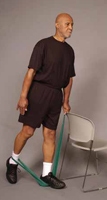
- Wrap a TheraBand resistance band around the ankle of your exercising leg
- Step on the band with the opposite foot to provide stability and hold the ends in your opposite hand
- You can hold onto the back of a chair for extra support while doing this exercise, if needed
- Keep your knee straight as you extend your leg outward against the band
- Keep your back straight and don’t lean
- Hold, slowly return, and repeat
- When you’ve finished the repetitions on one leg, switch to the opposite leg and repeat
2. TheraBand Hip Abduction (Kick Outs) in Standing
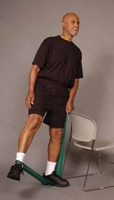
- Wrap a TheraBand resistance band around the ankle of your exercising leg
- Step on the band with the opposite foot to provide stability and hold the ends in your opposite hand
- You can hold onto the back of a chair for extra support while doing this exercise, if needed
- Keep your knee straight as you extend your leg backward against the band
- Keep your back straight and don’t lean
- Hold, slowly return, and repeat
- When you’ve finished the repetitions on one leg, switch to the opposite leg and repeat
3. TheraBand Hip Adduction
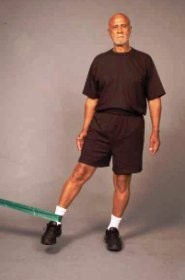
- Attach the ends of the band to a secure anchor point and loop the band around the ankle of your exercising leg
- You can use a sturdy object for support if needed during this exercise
- Bring your leg inward towards the opposite leg, working against the band’s resistance
- Hold, slowly return, and repeat
- When you’ve finished the repetitions on one leg, switch to the opposite leg and repeat
4. TheraBand Knee Curl in Standing
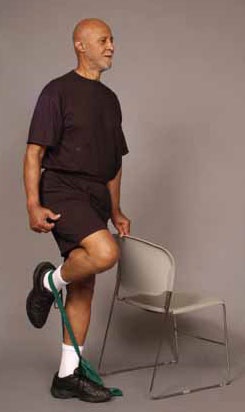
- Wrap a TheraBand resistance band around the ankle of your exercising leg
- Step on the band with the opposite foot to provide stability and hold the ends in your opposite hand
- You can hold onto the back of a chair for extra support while doing this exercise, if needed
- Slowly bend your knee upward against the band’s resistance
- Hold, slowly return, and repeat
- When you’ve finished the repetitions on one leg, switch to the opposite leg and repeat
5. TheraBand Knee Chair Squat
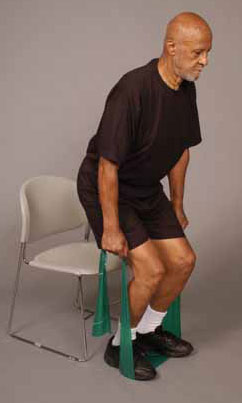
- Stand on the center of the band with both feet
- Hold one end of the band in each hand
- Keep tension in the band with your elbows straight
- Keep your elbows straight as you slowly bend your knees and lean forward slightly at the hips
- Keep your back straight
- Slowly return and repeat
6. TheraBand Hip Flexion in Sitting

- Sit on a sturdy chair
- Loop the middle of the band around the thigh of your exercising leg, just above the knee
- Bring the ends of the band under your opposite foot and step on them for stability
- Hold the ends of the band in your opposite hand
- Flex your hip against the band, pulling upward
- Keep your back straight and don’t lean forward
- Hold, slowly return, and repeat
- When you’ve finished your repetitions on one leg, switch to the opposite leg and repeat
7. TheraBand Ankle Dorsiflexion (Foot Raises) in Sitting

- Sit on a sturdy chair
- Wrap the middle of the band around the foot of your exercising leg
- Bring the ends of the band under your opposite foot and step on them for stability
- Hold the ends of the band in your opposite hand
- Lift your foot upward against the band’s resistance
- Hold, slowly return, and repeat
- When you’ve finished your repetitions on one leg, switch to the opposite leg and repeat
8. TheraBand Ankle Calf Raise in Standing
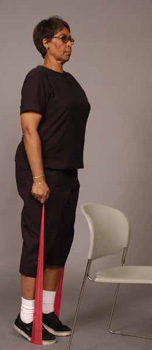
- Stand on the center of the band with both feet
- Hold one end of the band in each hand
- Keep your elbows straight and raise your heels off the floor
- Hold, slowly return, and repeat
Exercise Routine Part 2
For exercises 9-10, here is a general resistance progression. Your medical professional can help you come up with a program that fits your needs.
|
|
|
|
|
|
|
|
9. Step-Up
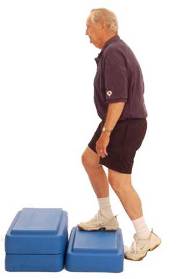
- Step up onto the stairs or steps while facing forward
- Use the railing or another sturdy object for balance if needed
- Repeat
10. Lateral Step-Up
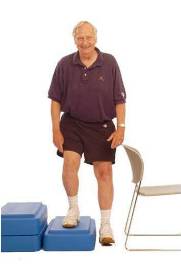
- Step up onto the stairs or steps while facing the side
- Use the railing or another sturdy object for balance if needed
- Repeat
Cool Down
After you complete your exercises, cool down with static stretching for 2 sets of 20 seconds each (glutes, hips, hamstrings, calfs, torso, upper back, lower back, and triceps). Finish up with five minutes of light walking.
Looking for more knee exercises?
Using an exercise bike or pedal elliptical can be a good way to exercise your knee and improve its range of motion without putting pressure on the joint (as long as your doctor approves). The Cubii Pro is one option to use for seated exercise before and after your knee replacement.

For more exercises, check out this video by Maine Medical Center!
3 Arm Strengthening Exercises
Exercises that strengthen your arms will help you prepare for using crutches or a walker after your knee replacement surgery.
Follow along with these three exercise videos to get started.
- Bilateral Bicep Curls
- Tricep Pushdown
- Bilateral Arm Raise
3 Options for Knee Pain Relief


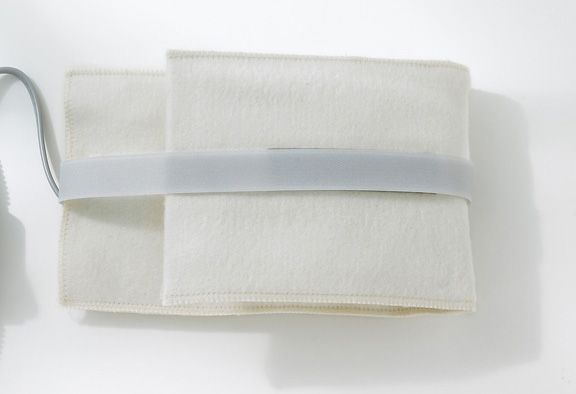
As you wait for your knee replacement, don’t wait in pain. Check out these options to relieve your knee pain now!
- Biofreeze
- This topical analgesic provides soothing, cool relief in the form of a gel, roll-on, or spray
- TheraPearl Color Changing Knee Wrap
- Use a TheraPearl knee wrap for hot or cold therapy, the tiny beads conform to your knee during use
- Moist Heat Electric Therapy Pad
- If moist heat relieves your pain best, try a joint wrap to help reduce your knee pain
Exercises Post-Knee Replacement
After your knee replacement surgery, check out these rehabilitation exercises to strengthen your knee and improve its range of motion!
References
- Kercher, J. (2019). What’s Knee Replacement Surgery? WebMD. Retrieved from https://wb.md/2YRyf2V
- Bozic, K. (2018). How to Prepare for Total Knee Replacement. Arthritis Health. Retrieved from https://bit.ly/2SMX106
- Zhang, S. (2020). What It Really Means to Cancel Elective Surgeries. The Atlantic. Retrieved from https://bit.ly/2YKoRhp
- Rooks, D. et al. (2006). Effect of Preoperative Exercise on Measures of Functional Status in Men and Women Undergoing Total Hip and Knee Arthroplasty. Arthritis & Rheumatism. Retrieved from https://bit.ly/2SKAam0
- Skoffer, B. et al. (2016). Efficacy of Preoperative Progressive Resistance Training on Postoperative Outcomes in Patients Undergoing Total Knee Arthroplasty. Arthritis Care & Research. Retrieved from https://bit.ly/2LbaESL
- News Now Staff. (2014). Preoperative Physical Therapy Results in 'Significant' Reduction in Postoperative Care Use for Patients Undergoing Hip or Knee Replacement. PT in Motion. Retrieved from https://bit.ly/2WCB3hB
- Sharma, R. et al. (2019). Does Rehabilitation before Total Knee Arthroplasty Benefit Postoperative Recovery? A Systematic Review. Indian Journal of Orthopaedics. Retrieved from https://bit.ly/2WGgRLs
- Topp, R. (n.d.). Prehabilitation Protocol for Knee Replacement Surgery. TheraBand Academy. Retrieved fromhttps://bit.ly/2xM7DFl
- Topp, R. (n.d.). Prehabilitation Protocol for Knee Replacement Surgery PDF. TheraBand Academy. Retrieved from https://bit.ly/35JLrbo
Medical Disclaimer: The information provided on this site, including text, graphics, images and other material, are for informational purposes only and are not intended to substitute for professional medical advice, diagnosis or treatment. Always seek the advice of your physician or other healthcare professional with any questions or concerns you may have regarding your condition.








 France
France Australia
Australia